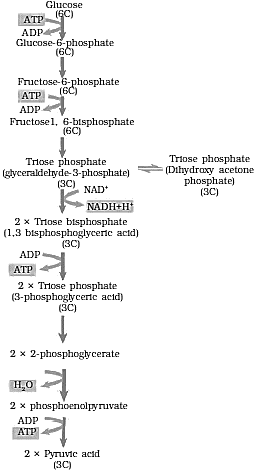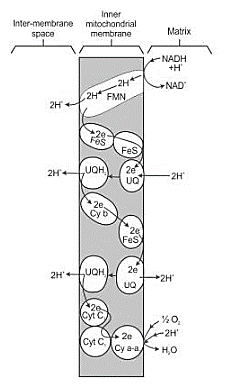1. Differentiate between
(a) Respiration and Combustion
(b) Glycolysis and Krebs’ cycle
(c) Aerobic respiration and Fermentation
Solution:
a) Respiration and Combustion
b) Glycolysis and Krebs’ cycle
c) Aerobic respiration and Fermentation
2. What are respiratory substrates? Name the most common respiratory substrate.
Solution:
Organic substrates that are oxidised during respiration to liberate energy inside the living cells are respiratory substrates. Carbohydrates, proteins, fats and organic acids are the most common respiratory substrate.
3. Give the schematic representation of glycolysis.
Solution:
The schematic representation of glycolysis is as follows:

4. What are the main steps in aerobic respiration? Where does it take place?
Solution:
The main steps in aerobic respiration are as follows:
- Glycolysis: Occurs in the cytoplasm(cytosol), where glucose is broken down to pyruvic acid.
- Oxidative decarboxylation of pyruvic acid to acetyl coenzyme-A: Takes place inside the mitochondrial matrix.
- TCA, or Krebs cycle, takes place in Mitochondrial matrix where pyruvic acid is oxidised to transform the energy contained in these molecules into ATP.
- Electron transport chain occurs in mitochondrial membrane involves ATP synthase complex.
5. Give the schematic representation of an overall view of Krebs’ cycle.
Solution:
The schematic representation of an overall view of Krebs’ cycle is as follows:

6. Explain ETS.
Solution:

- The electron transport system (ETS) is found in the inner mitochondrial membrane and aids in liberating and using the energy stored in the NADH+H+ and FADH2
- NADH+ H+, formed while citric acid cycle and glycolysis occur, is oxidised by NADH dehydrogenase or complex I.
- Electrons hence produced are conveyed to ubiquinone via FMN.
- Similarly, the complex II or FADH2 synthesised during the citric acid cycle is conveyed to ubiquinone.
- From ubiquinone, electrons are accepted by the complex III or cytochrome bc1, which furthermore gets conveyed to cytochrome c, which serves as a mobile carrier between the cytochrome c oxidase complex and complex III comprising of cytochrome a and a3 with copper centres (complex IV) additionally.
- When electrons are transferred from each complex, simultaneously other processes occur, such as production of the ATP from ADP and the inorganic phosphate through the action of ATP synthase (complex V).
- This amount of ATP production is dependent on the molecule that has been oxidised. 3 ATP molecules are generated by the oxidation of 1 molecule of NADH, while 1 FADH2 molecule, upon oxidation, produces 2 ATP molecules.
7. Distinguish between the following:
(a) Aerobic respiration and Anaerobic respiration
(b) Glycolysis and Fermentation
(c) Glycolysis and Citric acid Cycle
Solution:
a) Aerobic respiration and Anaerobic respiration
b) Glycolysis and Fermentation
c) Glycolysis and Citric acid Cycle
8. What are the assumptions made during the calculation of net gain of ATP?
Solution:
Assumptions made during the calculation of the net gain of ATP are as follows:
- NADH generated inside the mitochondria synthesises 3 ATP molecules during its oxidation.
- NADH formed during glycolysis sends its reducing power into mitochondria via the shuttle system.
- During oxidation of FADH2, 2 molecules of ATP are produced inside mitochondria.
- Formation of 3 ATP in the malate-aspartate shuttle (heart, liver and kidney) and 2 ATP in the glycerol phosphate shuttle (muscles and nerve cells).
9. Discuss, “The respiratory pathway is an amphibolic pathway.”
Solution:
Organic substances such as fats, carbohydrates, proteins, etc., liberate energy when they are disintegrated in the respiratory pathway. This phenomena is said to be catabolic in nature. The respiratory process that serves as a catabolic pathway for the respiratory substrates also serves as an anabolic pathway to produce different metabolic products and secondary metabolites. Thus, the respiratory pathway serves as a catabolic and anabolic pathway. Therefore, the respiratory pathway is an amphibolic pathway.
10. Define RQ. What is its value for fats?
Solution:
The ratio of volume of CO2 evolved to the volume of Oxygen consumed in respiration is called respiratory quotient (RQ) or respiratory ratio.

RQ is less than 1 when the respiratory substrate is either fat or protein.

11. What is oxidative phosphorylation?
Solution:
Oxidative phosphorylation is the conversion of ADP into ATP by electron transport system. Phosphorylation takes place in the inner mitochondrial membrane via the ATP synthetase complex when the hydrogen protons pass through it. The energy essential for phosphorylation is derived from the oxidation-reduction phenomena in respiration. Thus, the process is known as oxidative phosphorylation.
12. What is the significance of the step-wise release of energy in respiration?
Solution:
During respiration single molecule of glucose is disintegrated to generate carbon dioxide and water along with the formation of ATP molecules. If the energy gets released at one go, then most of energy will be lost as heat. In order to synthesise new compounds, the cell should be able to utilise the energy. Hence, the step-wise release of energy in respiration is most efficient in the conservation of energy.


.png)

0 Comments